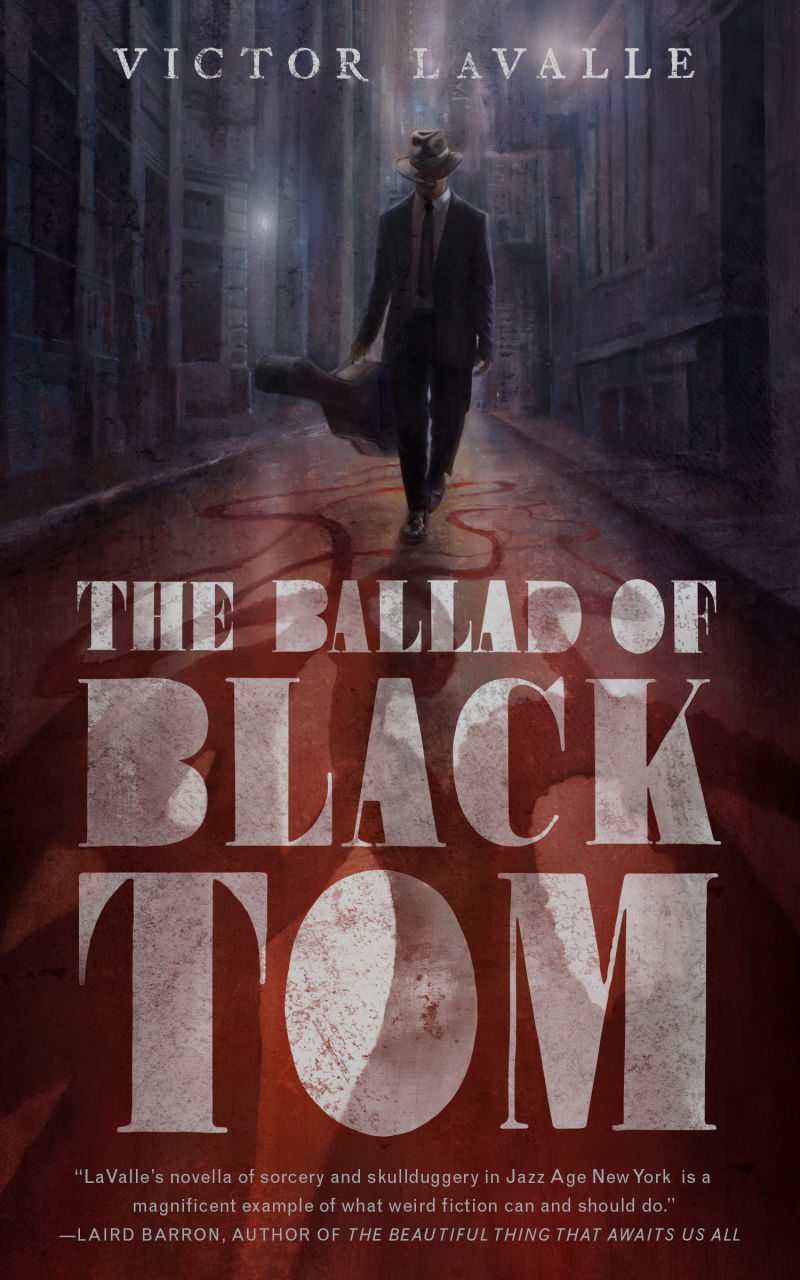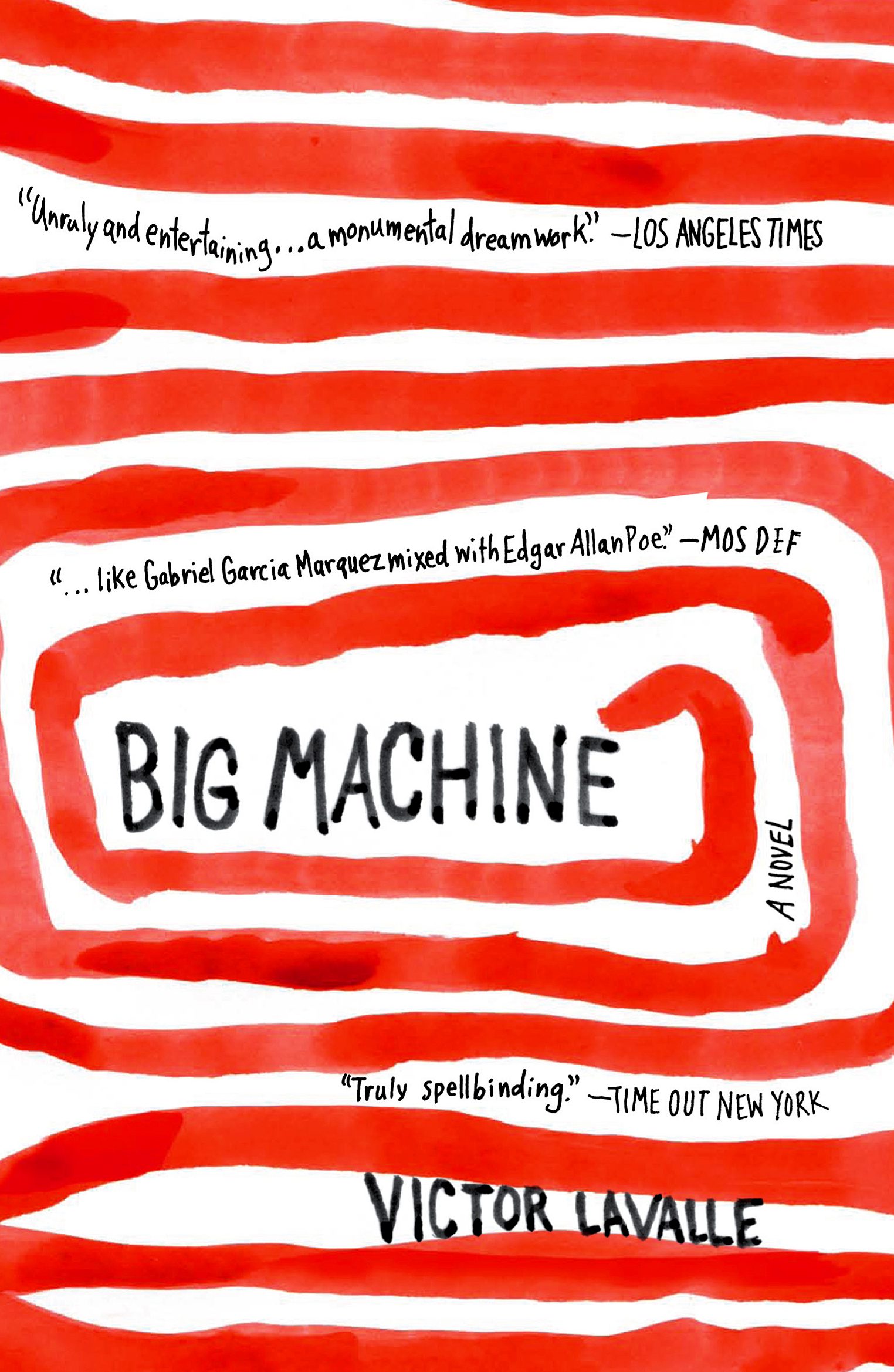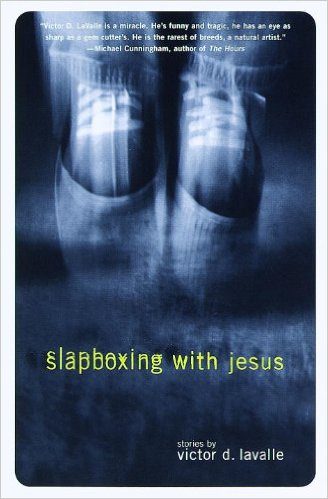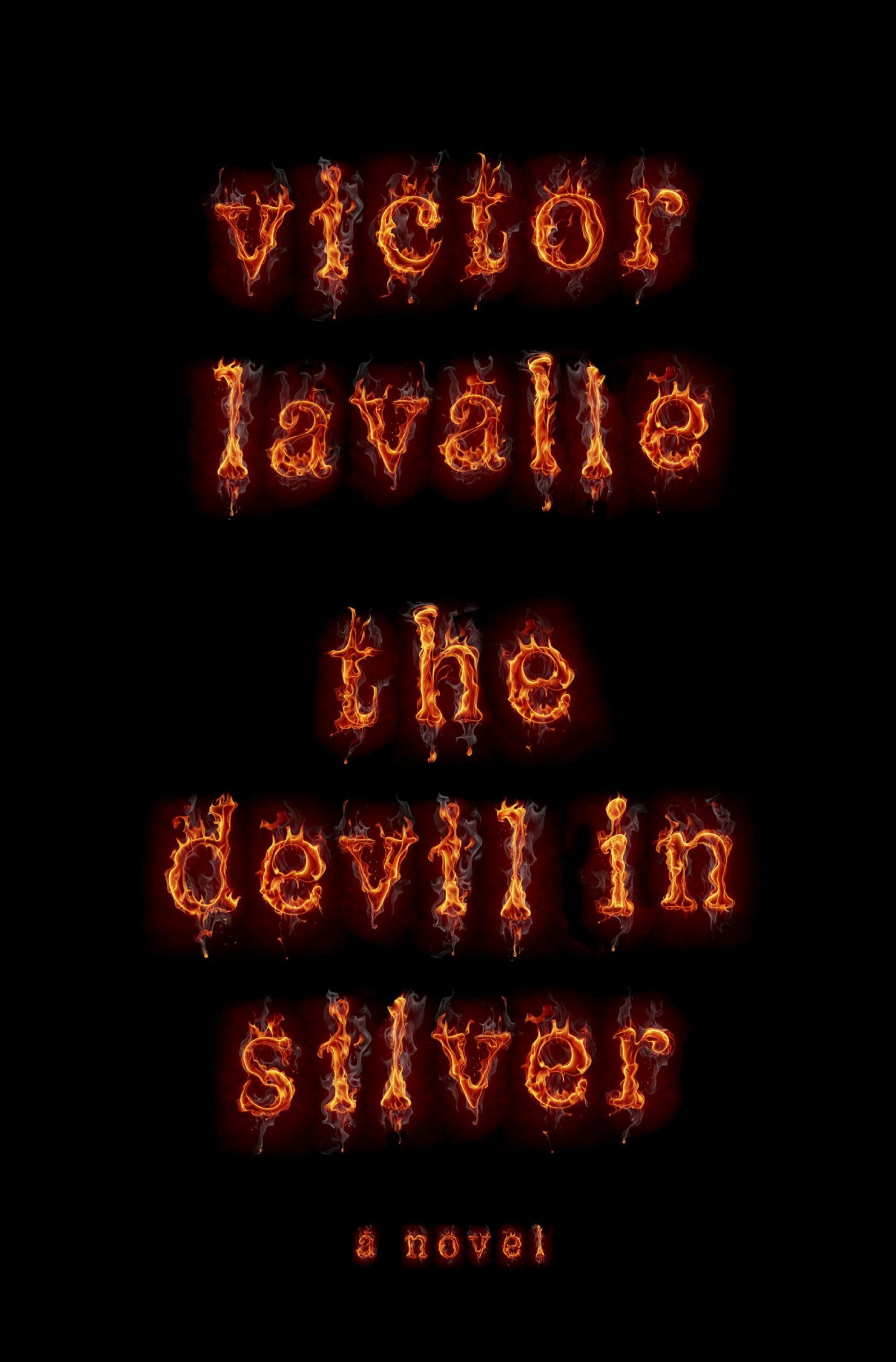Victor LaValle’s The Ballad of Black Tom is the latest entry in the award-winning author’s expansive, genre-bending archive. With novels and novellas that include Slapboxing with Jesus, Big Machine, The Ecstatic, The Devil in Silver, and Lecretia and the Kroons, and accolades like the Shirley Jackson Award and the American Book Award, LaValle has continued to amaze. His stories traverse time, place, and motif, refusing to be pigeonholed. With controlled prose, thematic richness, patient, doomful pacing, and carefully constructed plots, reading him is an immersive and entirely unique experience, making him one of the most exciting American novelists writing today.
While all of his books have deconstructed race, class, and bureaucracy in America, however, The Ballad of Black Tom goes right for the jugular. A frighteningly sharp reinvention of H.P. Lovecraft’s notoriously problematic The Horror at Redhook Road, LaValle’s new novella takes on some of the least savory aspects of Lovecraft’s work, while simultaneously breathing new life into it.
I recently had the great pleasure of speaking with Victor about his latest novella, along with his career as a whole.
***
The Rumpus: So let’s begin with the big question. Why do you write? Or if that sounds a little gauche, then let’s ask when you decided you really wanted to pursue writing as a career?
Victor LaValle: I wanted to write long before I wanted a writing career. Or, long before I understood such a thing might be a career. By eleven or twelve I wrote stories, usually mimicking those writers I adored, and I did it because the act made me incredibly happy. “I have this amazing story I want to tell you.” That might as well have been my motto. I didn’t think of this as a career, but I did plan to see my books in people’s hands, in bookstores and libraries. I didn’t think of making a living, but I did dream of reaching people.
Rumpus: You’re considered by many to be a literary writer that leans towards genre, rather than the other way around. I found The Ballad of Black Tom to reach even further into the depths of the uncanny than The Devil in Silver. This distance traveled seems especially dramatic when considering your first short story collection, Slapboxing With Jesus, which was a more literary project. Do you find that as you continue to write that you have to break out of boxes?
LaValle: I think of my writing from Slapboxing to Black Tom as following a path like the world’s great rivers—the Amazon or the Nile or the Mississippi. A single body of water that travels through many different territories. I take a little bit of each one with me as I make my way toward the open sea. And then I will become the sea.
Rumpus: As a follow-up question, do you think genre fiction has a special obligation to be introspective?
LaValle: Fiction is either thoughtful or thoughtless. The thoughtless stuff supports a series of ideas or beliefs that are generally accepted in a culture and does so without criticism or concern. Think about how much horror, both film and literature, is, in the end, about maintaining the central importance of the heterosexual white middle-class family. That’s just one example, but since I love horror it comes to me immediately.
A thoughtful version of the same story might still have the white heterosexual white family triumph (or at least survive) in the end, but the journey to that survival will have forced a certain amount of thought on the part of the reader if not the characters. (Though it’d be nice if they got to do so, too.)
If you make the distinction between thoughtful and thoughtless fiction then every genre requires scrutiny including the “literary.” Otherwise you just become this advertisement for the status quo. I can’t think of a worse fate for an artist.
Rumpus: In The Ballad of Black Tom, the main character, Charles Thomas Tester, is a salesman, who carries a guitar as a means to camouflage himself as he travels through a 1920s New York City where being black man on his own in the wrong part of town is warrant enough for extreme violence. Tester, while being decent on the guitar, is described as having a rather unsteady voice. What part does music play in The Ballad of Black Tom?
LaValle: I’m a man who always wanted to be a musician, but lacked the musical talent to realize the dream. I wanted to be a great heavy metal drummer like Dave Lombardo from Slayer, I even saved up and bought drums, but I didn’t have the perseverance to see it through at that age. But I still remembered sitting at my little five-piece kit and already feeling like the next great drummer in rock music. It was funny and little silly, but also beautiful. I wanted to imbue Tommy’s guitar with that kind of energy, but for the sake of a good story he actually had to go out into the world and do something with the guitar.
Rumpus: Your books have always left me with a quiet sense of dread that sneaks up on you unsuspecting. While reading The Devil in Silver and Big Machine I found myself recalling 1970s-era horror films that thrive on suggestion like Rosemary’s Baby or The Omen. I won’t say that your books are bloodless, of course. But they do feel patient. Is that intentional?
LaValle: It’s constitutional. I love the long slow build up in any kind of storytelling, that’s really in any genre. It’s what I like best about someone like Shirley Jackson or Haruki Murakami, that patience and detail. When I trust the author—or filmmaker—is leading me toward something that will really be worth my patience then I can get completely lost in the atmosphere of mounting dread or weirdness. An old school writer like Algernon Blackwood could make whole stories out of almost nothing but the build up. It’s glorious. I only dislike that kind of pacing when the writer has mistaken being dull for being patient.
Rumpus: You seem to like writing about monsters. In The Devil in Silver, the monster lurks in a mental institution in Queens. In The Ballad of Black Tom, it resides in the cosmic just-beyond. Why do you find them so interesting?
LaValle: Doesn’t everybody love monsters? Monsters of one kind or another? They’re just so much bigger than the norm and that’s enticing, exciting. This goes for Frankenstein’s monster or someone’s monstrous mother. I think the good ones, the well-done monsters, give a sense of the human scale. We see our worst selves in them and shudder. Those are the best monsters for me. Think of Norma Desmond from Sunset Boulevard. Jack Torrance in The Shining. Bob from Twin Peaks. All the evil stepmothers from fairytales. Each of them is an exaggeration of real-world, human problems but the exaggeration is crucial. Oddly, the outsized nature can make them more recognizable. It’s magical when it works well.
Rumpus: As a longtime Victor LaValle enthusiast, I can attest that all of your books have dealt with race. But The Ballad of Black Tom seems like the first one to take it as its prime focus. There are a couple moments in particular that I won’t name here where it appears that you, as the author, speak directly to the reader through the mouth and mind of Charles Tester, rendering the story somewhat of a parable. Was this a book you wanted to write, you had to write, or both?
LaValle: Yeah, I thought of this book as a great horror story wrapped around a serious political concern. It’s a pig in a blanket kind of thing. Also, I was writing in conversation with H.P. Lovecraft’s fiction wherein he is often quite explicit about his feelings about race. (Not a fan of non-Aryans.) So to me it made complete sense to speak directly to the reader, to Lovecraft, in the book. If he can do it, I can do it better. That was my working philosophy.
Rumpus: Can you talk about how H.P. Lovecraft affected you as a writer? When was your first encounter with his work, what made you fall in love with him, and when did you first realize that you and he had some disagreements?
LaValle: I read H.P. Lovecraft for the first time at ten or eleven years old. Del Rey books put out these paperback collections of his stories in the early eighties. They had this beautiful, but horrifying images on the front, exactly what would draw a ten-year-old kid’s eye. Lovecraft’s stories aren’t all that interesting as far as the plots go—many of them are basically interchangeable—but he could do atmosphere like few others before or since. That’s what drew me in. His haunted New England mansions, decaying fishing towns, places that sounded so exotic to a kid in an apartment in Queens. I didn’t even notice, at that stage, that his fiction was peppered with some pretty ugly ideas. It wasn’t until I turned fifteen or sixteen that I understood what the hell was going on. First I felt angry, then, I guess, I felt hurt. How could I love this guy so much and discover he loathed me?
Rumpus: The Ballad of Black Tom does something incredibly gutsy and intriguing. It channels H.P. Lovecraft’s The Horror at Red Hook, a work so fantastically racist it transcends the author’s xenophobic oeuvre. The Ballad of Black Tom is definitely a reinvention of that tale, rather than a reboot, and it puts some of the original characters, like the investigator Malone, and the white channeler of Asian magick, Robert Suydum of Red Hook, Brooklyn, under a magnifying glass. The result reminds me in some ways of what authors like Gregory McGuire have done with Oz, or perhaps more similarly, Mat Johnson with Edgar Allen Poe. What went into this fantastical reimagining of such socially fraught material, and what challenges did it propose?
LaValle: I chose that story because it was one of the only ones that took place in my hometown, New York, so I felt a deeply personal connection. Last year I reread a lot of his fiction and found that story as ugly as you say, but I thought I saw the opportunity to recast or, as you say, reimagine what he’d written. The story had just enough plot and atmosphere for it to feel solid, but it wasn’t one his truly great stories. I wouldn’t have tried to recast, or outdo, anything like “The Call of Cthulu” or “At the Mountains of Madness” because those are Teflon. Those strike me as perfect because they completely embody the depth and breadth of Lovecraft’s imagination. But “The Horror at Red Hook” had plenty of gaps, many sections where I thought I could muscle in and take over. The biggest issue was figuring how much to keep and how much to toss out. The mistake a lot of writers make when they write homages is that they’re too respectful of the source material. But that source material is in no way changed, or diminished by your version so why play nice? I took out everything that wasn’t useful and replaced that stuff with better parts.
Rumpus: Setting seems to play a big part in your stories. From Oakland to Queens, and now to Harlem, Flushing Meadows, and Red Hook, you pay a lot of attention to the history of cities. Can you talk a little about why you find place to be so important?
LaValle: I’d just read Denis Johnson’s Train Dreams and before that I read Hillary Mantel’s Wolf Hall. Both did such a masterful job of writing an earlier era with great assurance and detail, but without making the writing seem archaic or arch. Those two examples fueled my research and my writing in Black Tom. On the larger scale I love writing about places—the history of a location—because the shit is just fascinating. Even better when you can pick or choose details that in some way inform the story you’re trying to tell. Historical detail included simply for the sake of detail isn’t worth anything, but if it colors the reader’s understanding of the character or the plot then it’s going in every time.
Rumpus: The Ballad of Black Tom is a novella. Why did you decide on that length and format?
LaValle: I love novellas. They’re so good for when you have a story that demands a little time to tell, but still makes you want to devour it in a night. Train Dreams is one great example. Shirley Jackson’s We Have Always Lived in the Castle is a novella (though it’s billed as a novel) and so artfully compressed that it doesn’t need even one extra word. Kenzaburo Oe’s novella Prize Stock works this magic and Clive Barker’s Hellbound Heart. (It’s the inspiration for the Hellraiser movies, but worth reading all on it’s own.) I can’t say I decided on the length so much as the story dictated it. I needed that much room to tell the story and no more.
Rumpus: I’ve seen you lament the fact that many great authors, particularly horror authors across the last several decades, are no longer in print. Authors like Ted Klein, for instance, or Fritz Leiber. Recently, Thomas Ligotti and Ray Russell, whose stories have remained in the shadows for years, have received more mainstream literary attention. Why do you think it takes so long for certain authors make their ways into the hands of readers?
LaValle: Well, it takes a long time for almost every author, in every genre, from every nation, and in every time period, to make it into the hands of readers. And most never do. This is just the lot of writers. You toil and sweat and love this book, that story, and then you set it free in the wild. What a wild, beautiful act. I mean, are we so insane, so arrogant, so naïve, that we really believe some stranger, half a century from now or half a mile away from our home, is going pick up our books and be moved? Yes! Bless every single one of us, we can’t stop ourselves.
Rumpus: We seem to live in the era of reinvention. Of retelling old stories with renewed inclusiveness. The Ballad of Black Tom seems to epitomize this trend. Can you talk about that? Do you think there are any downsides associated with reinvention?
LaValle: Throw it all against the wall. Why not? There’s rebooting and there’s reinvention. It’s worth remembering that Lovecraft took a great deal of influence from writers like Algernon Blackwood and Lord Dunsany. If you read some of Lord Dunsany’s work you’ll have a much better understanding of where Lovecraft’s arch language comes from. And Blackwood’s “The Willows” is easily identifiable as one of Lovecraft’s great influential texts. So I think reinvention is a healthy, and longstanding, part of literature. The Great Gatsby has been reinvented so many times (and sometimes really damn well). The downside, I suppose, is if there’s no vital reason to appropriate the old. It’s not a remix if you don’t do anything new to the track. A writer liked Ernesto Quinonez absolutely used The Great Gatsby as a model but Bodega Dreams is its own creation.
In 2014, you wrote a story in a Hellraiser comic. It was quite good. I also once read that you cut your teeth on comics. Can you expand on that a little?
LaValle: Started with picture books, graduated to comic books, and eventually included prose, too. What’s not to love about comics? They can be such a sophisticated form of storytelling though I didn’t understand that when I first began. Superheroes are a lot like monsters that outsized humanity kind of thing. A space big enough for a child like me to slip his imagination into. My sentimental favorite probably remains Judge Dredd. Those comics were just so bonkers, stewed in all the pain and paranoia the 1970s could offer.
Rumpus: Are there subgenres of horror that you don’t care for?
LaValle: I couldn’t imagine dismissing any kind of writing—by genre or subgenre—completely. There’s always going to be at least a handful of people in there doing smart, interesting work. For me it still goes back to whether a book is thoughtful or thoughtless. If a book is only about it’s plot then I can’t really tolerate it.
Rumpus: What’s your opinion on B horror movies, and their literary equivalents? Why is it that bad horror can be so good?
LaValle: It’s always fun to watch people having fun. At least that’s my take on the best B movies. I don’t mean the ones you can just sit and laugh at because they’re terrible, I mean the ones so over-the-top, so outlandish that you know these folks mean for you to have a blast. A secondary point is that sometimes B movies will have some genuinely interesting ideas at play, enough so you just want to see the thought of the movie through. And sometimes you’re just high and want to kick back and cool out. A B movie is basically the next part of your trip and that’s a gift.
Rumpus: Are you going to continue writing about monsters, cosmic dread, and the underbelly of humanity? What’s in the cards for Victor LaValle, going forward?
LaValle: I’ve got a full-length novel coming out in 2017. Title isn’t definite yet. Doing the last edits now. I’m damn excited about that one too. Monstrous things happen in it. Beautiful things, too.








